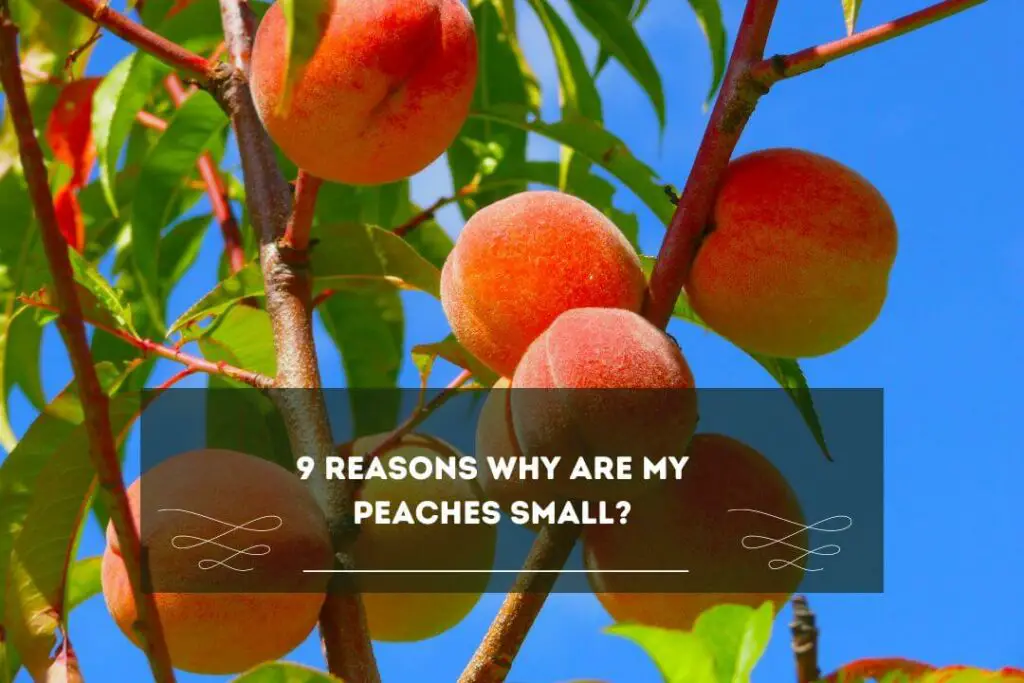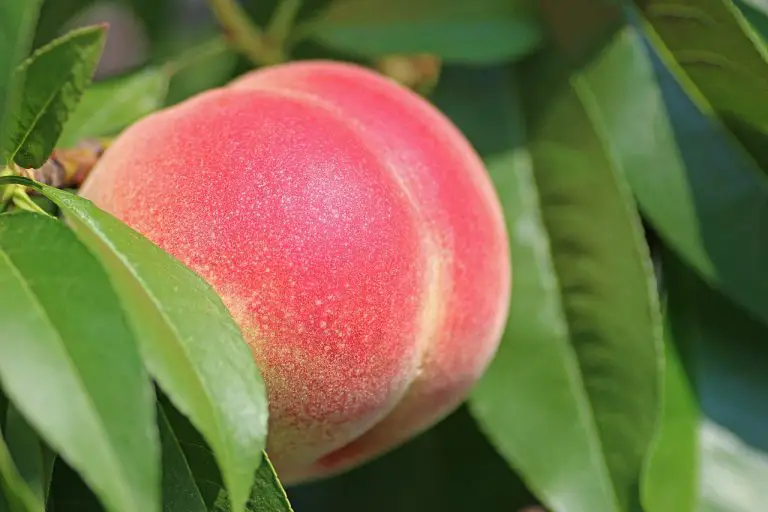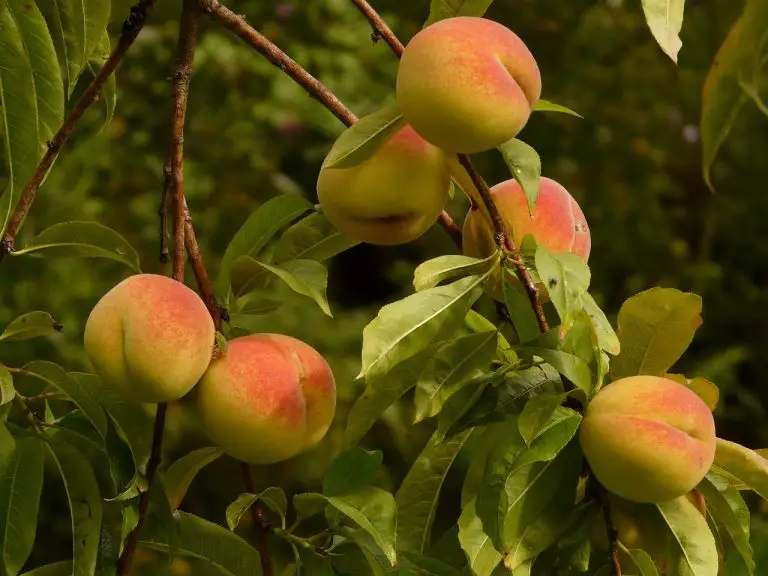Don’t be so if you are frustrated by your peach tree’s small fruiting size. In this case, you are not alone. Many peach tree owners have frequently complained about struggling to achieve the big juicy fruit they always wanted and craved.
In this article, I will answer the most asked question: why are my peaches small? I have received many emails from people asking, ‘my peace has small fruit, and what can I do to overcome this issue.’
Since there can be many reasons your peaches may be small, we will discuss each in depth with the right approach and techniques to fix it. Here we’ll look at nine possible reasons why my peaches are small.
In this article, you will understand the impact of weather conditions and fertilization for successful harvesting and the proper technique for pruning your tree.
9 Reasons Why Are My Peaches Small?

Improper Pruning
Do you know about the study of the journal HortScience regarding short pruning techniques, which can increase fruit size & yield in peach trees?
Throughout my gardening journey, I not only learned that pruning is an essential part of maintaining a healthy tree, but also it is essential to do it correctly.
If you’re pruning your peach tree too much or at the wrong time of year/season, this might be the reason for your peach tree fruit’s reduced size and quality. As per research, you should only prune your peach tree in late winter or early spring before the buds swell.
Researchers from the University of Florida proved that pruning lateral branches to one-third of their length will stimulate new growth while promoting the development of larger fruit. Therefore I will highly advise you to focus on removing dead or diseased wood and any branches crossing or growing toward the tree’s center.
Consider thinning the remaining branches if required or possible for better air circulation and light penetration. According to the PSU, it is highly recommended to prune your peach tree annually to maintain its health and fruit productivity.
How To Prune A Small Peach Tree?
- Firstly you need to start by removing any dead or damaged wood from the tree. Therefore I highly recommend you get sharp, clean pruning shears that can make clean cuts at the base of each branch or twig. This will help you prevent the spread of disease & promote new growth.
- Next, you need to remove any water sprouts or suckers that are growing from your peach tree’s base or trunk. Trust me; these shoots will sap energy from your tree and prevent it from producing the larger fruit you want.
- Now, you need to check for branches crossing or rubbing against each other. If any are found, you should consider removing them to prevent damage to the bark.
- Fourthly, I will advise you to Identify the main scaffold branches, the larger branches that form the tree’s framework. According to the rules of thumb, having three to four scaffold branches evenly spaced around the tree’s trunk is recommended.
- If you find any lateral branches growing from the scaffold branches, prune them back to about one-third of their length. You may not see it as very helpful but believe me; this will encourage new growth while keeping your tree balanced for better production.
Lastly, you must always thin out any excess fruit on the tree. Too many peaches can prevent the tree from producing larger fruit, which we will also discuss in the following section of this article.
Removing any fruit that is damaged, misshapen, or overcrowded is essential. I will also advise you only to leave the largest and healthiest to ensure as it will ensure plenty of nutrients and space to grow.
Unfavorable Weather Conditions
Being a responsible gardener, you should always determine the specific requirement of a particular specimen or tree species before planting it. Since peach trees require a certain amount of warmth and sunlight to produce large, juicy fruit, ensure no unusual temperature change or unfavorable weather conditions exist.
If your peach tree is experiencing an unusually cool or wet summer, its fruit size & quality can greatly drastically be affected. According to the Research published on ResearchGate, unfavorable weather conditions like cold temperatures or excessive rain can lead to smaller fruit sizes.
Unfortunately, there’s not much you can do to control the weather if this is what is causing the problem. However, you can take a few steps to protect your tree from frost and other weather-related issues affecting its fruit size/quality. If possible, you can use a frost blanket to cover and protect your tree from extreme weather conditions.
Improper Watering
I don’t need to tell you that over-watering or under-watering can cause stress to your peach tree, which will also affect the size and quality of its fruit. You should note that peach trees need deep, infrequent watering, which is usually once per week.
Ensure you avoid getting water on the leaves or fruit of your peach tree, as it can also increase the risk of disease. However, If you’re unsure how much water your peach tree needs, I recommend purchasing a moisture meter and using it to determine when it’s time to water your tree.
According to a study of UC Master Gardeners of Napa County weekly column, under-watering usually leads to trees’ small fruit than those that received the correct amount of water.
Lack Of Pollination
If you are looking for a great harvest,t peach trees also need pollinators like bees to produce fruit. If there aren’t enough pollinators in your area or your garden, the peach tree fruit will likely grow misshapen or small.
It can also be affected if weather conditions aren’t conducive to pollination. Suppose this is the case, I highly recommend you encourage pollination. Thus, it would be best to consider planting pollinator-friendly plants around your peach tree.
Alternatively, you can attract mason bees or pollinators to your garden. Lack of pollination can also lead to small fruit. According to a recent study by the University of Illinois, trees like a peach that were not adequately pollinated produced smaller fruit than those that received adequate pollination.
So, you better decide what you want. I advise you to consider growing a pollinator-friendly flower bed around your peach tree.
Poor Soil Quality
Peach trees require well-draining soil that’s rich in nutrients. Suppose your soil is compacted or lacks essential nutrients like nitrogen, phosphorus, or potassium. In that case, your peach tree may not be able to absorb enough water and nutrients to produce large, healthy fruit.
To improve your soil quality, you may want to consider adding compost, fertilizer, or other soil amendments to your soil. You may also want to consider testing your soil to identify any nutrient deficiencies that must be addressed.
Lack Of Sunlight
I don’t need to tell you that sunlight is essential for fruit tree growth and production in peach trees. If your peach tree is not getting enough sunlight, it will not be able to photosynthesize & produce the energy it needs to create large, juicy fruit.
I highly recommend you check if other trees or buildings shade your peach tree. If this is the case/cause, you should consider pruning or removing those obstacles to allow more sunlight to reach your tree. Alternatively, you can consider relocating your tree to a sunnier spot.
Too Much Fruit
If your peach tree has too much fruit, it’ll lead to smaller fruit. Since your peach tree’s resources will spread too thin, it will also be unable to devote enough energy to each fruit.
To prevent this, you should focus on thinning your fruit correctly. Thinning involves removing some of the fruit when they’re still small. It will help the remaining fruits or peaches to grow bigger, better, and sweeter. If your peaches are small in size, it might be due to a lack of space,
I will advise you to provide about 6-8 inches of space between each peach on the tree. According to the University of California Cooperative Extension, it’s essential to thin peach trees to no more than 6 inches apart.
Wrong Variety
Some peach varieties are naturally smaller than others. Maybe you’ve chosen a type known for producing small fruit or cannot fruit successfully as it should be due to unfavorable weather conditions.
Some peach varieties are naturally more minor than others, and if this is the actual reason, you will have to choose a combination that’s well-suited to your growing zone and soil type and produces the big-sized fruit you’re looking for. Do you know that there are few self-pollinating peach tree species? Never mind reading our article on 7 popular self-pollinating peach trees.
Pests & Diseases
Like any other three in your garden, your peach trees are susceptible to various pests and diseases, including peach twig borer, oriental fruit moth, brown rot, and bacterial spot.
These are only a few pests and diseases that can damage your peach tree fruit by reducing its size or causing it to drop prematurely. Therefore I highly recommend you prevent problems and diseases from affecting your fruit by practicing and adhering to good sanitation. Make sure you’re using appropriate pest & disease control measures as needed. If you want to know what bug is eating my peach trees, check this guide, where you’ll learn many things, including common pests of peach trees in a chart format.
You might find a few other topics very helpful that I’ve covered on peach trees. Nevermind, check one of these out.
Conclusion
After reading this article, you already know there can be several reasons for small peaches. One prominent case is that lack of sunlight, poor soil quality, improper watering, pests and diseases, lack of pollination, improper pruning, having too much fruit, choosing the wrong variety, and unfavorable weather conditions may affect the fruit size and quality of your peach tree.
Therefore I highly recommend you identify the cause of the problem, and then you should take steps to improve your peach tree’s health while encouraging it to produce larger juicier fruit.
If you provide the proper care and attention, I expect you will enjoy a bountiful harvest of delicious, full-sized peaches from your tree. At last, if you are still unable to find the reason behind your peach tree fruits being small in size, never mind, take a tourist consultation.
I tried my best to give you all the information about why my peaches are small. If you find this article helpful, then consider sharing it. Your share will help many people learn how to prune their tree correctly and encourage it for better fruiting/production. See you in the next post, till then, take care and goodbye.







